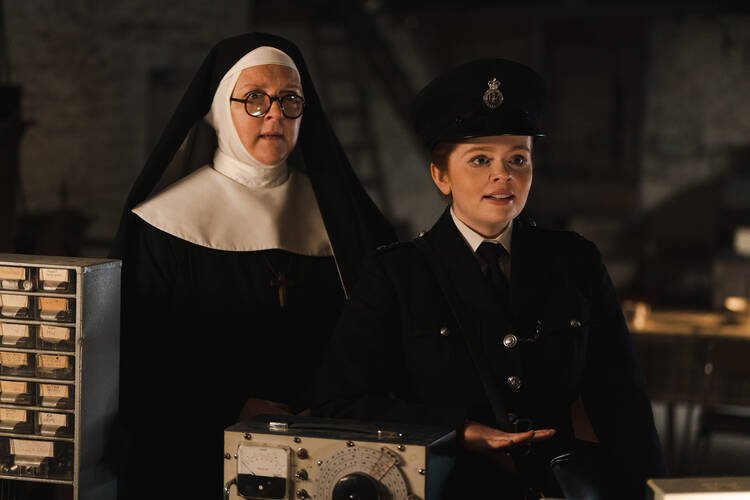Last year I heard about a new British mystery show on Britbox called “Sister Boniface Mysteries.” I was reluctant to indulge in it. Television portrayals of religious figures almost never go well. We’re either out of touch and inhuman or unrealistically holy, which to my mind is usually even worse.
But watching the series, I was blown away. Rather than a sneering monster or impossible saint, Sister Boniface reminded me of so many great women’s religious that I have had the good fortune of knowing—enormously competent, of deep integrity and undaunted in their commitment to helping people despite the many obstacles thrown at them by the world and sometimes the church.
Jude Tindall first wrote the character of Sister Boniface for the “Father Brown” mysteries. The actress and comedian Lorna Watson plays her with a uniquely merry generosity.
And the show itself, set in a sleepy rural English town in the 1960s, in which Sister Boniface works as a vintner at the local convent while using her Ph.D. in chemistry to help local police solve crimes, is also imbued with a profound sense of care for humanity. There is nothing preachy about the series, no heavy-handed pitch toward faith or morals, but the show is consistently interested not just in finding killers but in understanding them, in seeing them with the same kind of openness and compassion that we imagine Jesus would have.
Sister Boniface is the product of two impressive women. Jude Tindall, the show’s creator, first wrote the character in a 2013 episode of the “Father Brown” mysteries. The actress and comedian Lorna Watson played her then and since with a uniquely merry generosity.
In a recent interview on Zoom, Ms. Tindall told me that the character of Sister Boniface began with someone she knew. “Sister Boniface is actually inspired by an old teacher of mine,” she said. “She was a naval surgeon, the first female wing commander in the R.A.F. and a Protestant. Then she became a Catholic nun. She was called Sister Agnes Bartel. She ended up running a department in University College London.”
Ms. Tindall was educated by sisters at a convent school and raised Irish Catholic: “We’ve got more nuns and priests in my family than you can shake a stick at.” In fact one of her aunts is one of two sisters who serve as consultants on the show. “If we get something wrong, they’re quick to tell us,” she noted, laughing.
Television portrayals of religious figures almost never go well. We’re either out of touch and inhuman or unrealistically holy.
Ms. Watson, whose mother also attended a convent school, pointed to Tindall’s writing as central to her take on the character: “I just felt a connection with her, her sort of playfulness, the eager beaver in her, her thirst for knowledge. Her wide-eyed curiosity for the world really appealed to me.” But something else also unexpectedly elevated her performance: the costume. “Putting on the habit for the first time, something really magical happened. I don’t know how to describe it, really,” she told me. “It just makes me look so different that I can’t help but be other. It’s such an incredible thing to wear.”
Ms. Tindall agreed: “When you’re on set and Lorna’s there in the habit, she sort of glides around with this peaceful smile on her face, smiling benignly upon everybody and spreading her love.”
“It’s really funny,” Ms. Watson confessed, “Miranda [Raison], who plays Ruth the journalist, said to me once, ‘I always feel so calm on set. And I think it’s because I’m always sitting next to you dressed as a nun.’ Something happens almost by osmosis. It’s really interesting.”

For Ms. Tindall, the core to Sister Boniface’s character is her vocation as a scientist: “She might be Catholic, but she’s driven by logic and science. That is her métier.” Sometimes in the Catholic world, science is presented as a field that needs the church’s moral guidance. But for Ms. Tindall, it’s actually science that empowers Sister Boniface’s sense of compassion and respect. “Because she is a logician and a scientist, she’ll have looked at all the arguments,” she explained. “She’ll have gone from high Catholicism to atheism, she’ll have read all the texts.” With study comes greater understanding.
So in a recent episode investigating a murder among a group of white witches, while some of Boniface’s fellow sisters and other Catholics condemn the women as devil-worshipping monsters, Boniface is the one character who gives them the benefit of the doubt and keeps speaking on their behalf. And her care for them is really beautiful.
Some of what has emerged as the endearing aspects of the show, Ms. Tindall confides, are really happy accidents. So Sister Boniface’s Vespa, which perfectly captures her sense of freedom and adventure, was chosen for “simple practicality. She had to get around, and the convent was in the middle of nowhere.” Ms. Watson noted that she’s currently filming an episode of Father Brown, which is set 10 years before her series: “I’m on a pushbike. I can’t tell you how much I miss my scooter.”
Sister Boniface reminded me of so many great women’s religious that I have had the good fortune of knowing.
Likewise the decision to include other sisters, each with her own distinct take on her shared vocation, was not developed to represent the diversity of religious life, which it does so well. Rather, it was in order to locate Boniface in her proper context. “Because Sister Boniface was a nun, we felt that we had to see her in her own environment,” said Ms. Tindall. “And it couldn’t just be the Reverend Mother. We felt we needed at least three nuns in the convent to show the community, as it were.”
Ms. Watson said that working with the other actors playing the sisters is one of the great joys of the show. “It’s really funny watching us altogether, the small differences,” she said. “We all have little mannerisms to set us apart from each other, like Sister Reg is more hands-on hips and Sister Peter is a little bit more timid and mouselike with her fingers.”
“But also there’s this collective feeling of togetherness that you get from us all looking the same which I really love,” she said. “It makes you feel very united.”
While “Sister Boniface” is not a comedy, Watson plays the role with a delight that is also often very funny.
Ms. Watson comes from a sketch comedy background. She and her comedy partner Ingrid Oliver have performed together for many years, including on their two-season sketch show “Oliver & Watson” on BBC in the 2010s, which spoofed everything from “Mad Men” and teenagers on a date night to the practice of referring to people as “darling” or “love.”
While “Sister Boniface” is not a comedy, Watson plays the role with a delight that is also often very funny to watch. Tindall reveals that sometimes the writers aren’t aware of the humor Watson has mined until they see the episodes: “When we write the scripts, even if we haven’t written stuff in, [Watson] will look to wring the best comic potential out of any scene, even if it’s a really dull expositional scene.”
“It’s true, my natural instinct is to find comedy in things,” Ms. Watson said. “I don’t know where that comes from. It’s just my comfort zone.”
At the same time, there is a real truth to Watson’s performance. You never have the sense that she’s playing Boniface as a caricature or pratfalling for a laugh, which is part of why her performance resonates.
“Sketch comedy is all about very quickly finding things that make a character instantly recognizable,” specific details that help people understand who they are, Ms. Watson explained. “I think maybe it helps me identify certain little traits that might make Boniface feel like Boniface.”
In the Catholic faith we imagine that everything in the universe, from a sunset to even losing a loved one, can become a vehicle for revelation. “The world is charged with the grandeur of God,” wrote Gerard Manley Hopkins. Watching Sister Boniface (and Lorna Watson) at work, I’m touched by the profound hopefulness they offer to us. Life has tragedies and setbacks, and yet through Boniface’s eyes the world is always fundamentally a place of wonder, and human beings beloved souls.
“It’s a very nice place to spend an hour of your evening in,” Ms. Watson agreed. “A lot of love goes into this show.”
Correction, May 1:The title of the show has been updated in this review to ‘Sister Bonface Mysteries.’ The spelling of Jude Tindall’s name has also been corrected in a photo credit, and the source of the lead photo has been corrected to Britbox.








